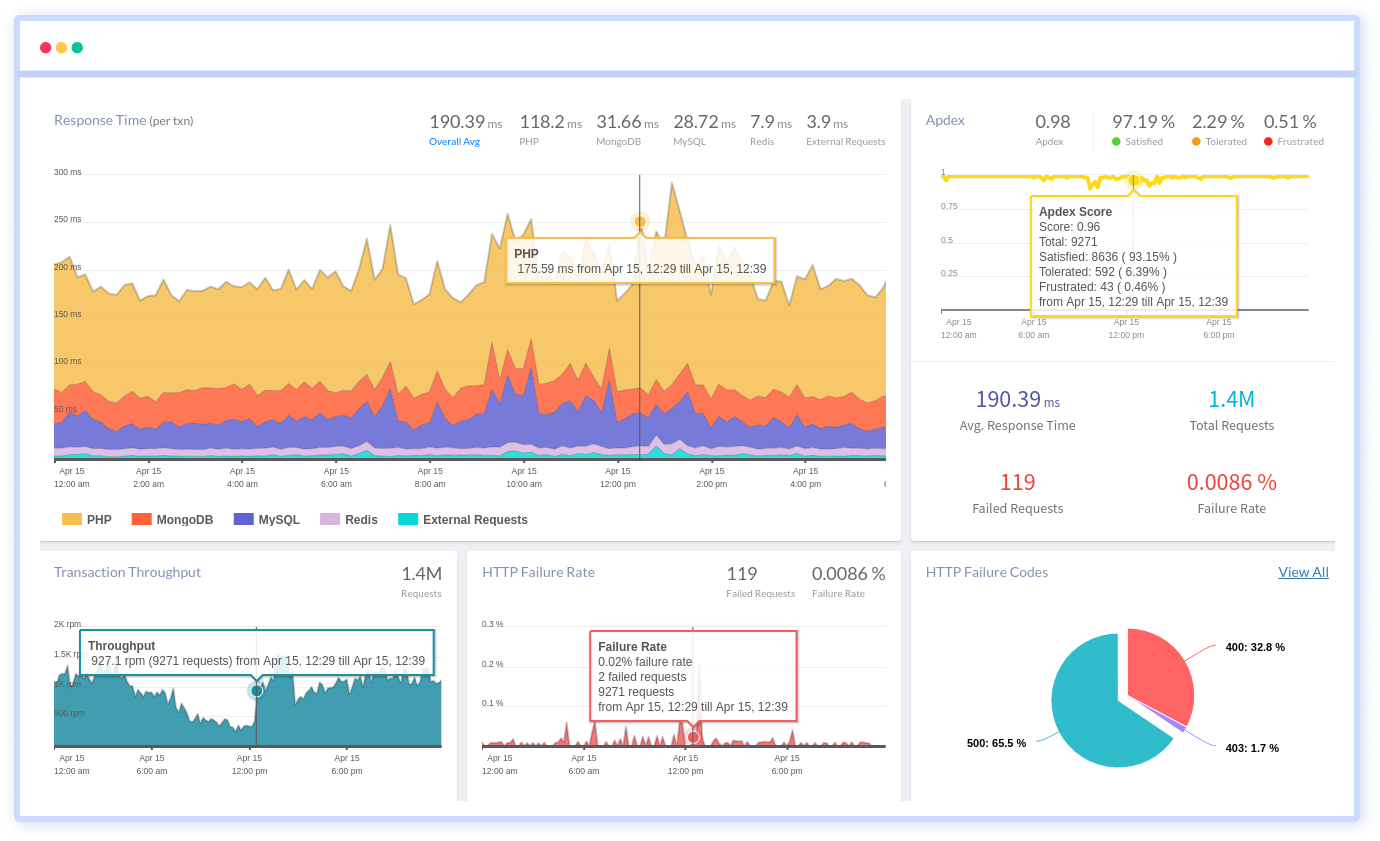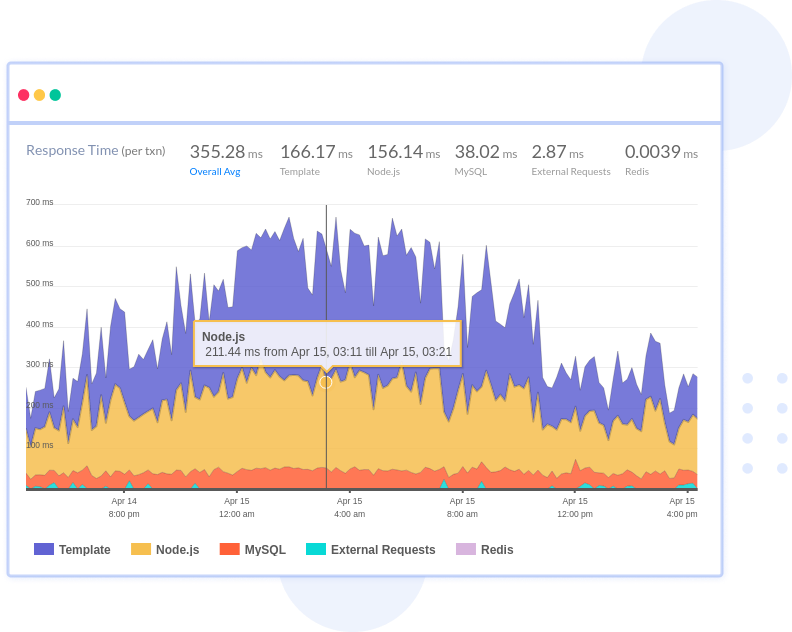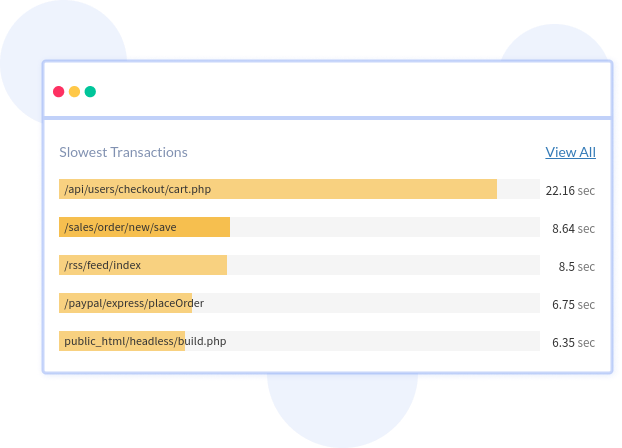
Hassle-free full stack monitoring
Monitor full-stack with actionable and real-time insights to help you diagnose and improve your web and backend applications. Use Atatus to obtain unified monitoring and performance bottlenecks. Begin optimizing your app to provide the most promising digital experience for your users.
Deliver the flawless application Performance
Proactive Monitoring
Deploy and get started within minutes of seeing key application performance metrics for actionable insights.

Detect Errors
Start optimizing to boost your application's performance with rectified errors of telemetry data.
Accurate Metrics
Capture potential performance metrics and log them to check where your endpoints are being probed or exploited.
Intuitive Dashboard
In-Depth insights on error tracking and metrics on potential key performance that impact business.
Real-time Alerts
Get notification alerts through various channels, including Slack, Teams, Email, PagerDuty, and more.

Guaranteed Value
Simple and transparent pricing that drives more value for your money, just like an investment.
Improve your full-stack in easy steps
Comprehend your front-end performance issues.
Unique qualities tailored to your use case.
Achieve comprehensive insight.
Streamline API issue resolution.
Monitor code deployments.
Instant code level tracing.

Forecast backend requirements.
Increase application stability and uptime.
Comprehensive alert system.

Enhanced synthetic tests and reports.
Test your app from an end-user perspective.
Increase resiliency.
Streamline log data.
Log retention and recovery.
Log searching and filtering.

Ensure API functionality.
Comply with security and quality standards
Verify API payload data.
Complete visibility throughout your tech stack.
Automated encountering error logs.
Rapidly resolve errors with code-level diagnostics.

Improvise slow loading pages.
Analyze front-end performance metrics.
Pinpoint JavaScript errors.

Atatus - Monitor your Application
Understand UX and front-end errors.
Monitor code deployments.
Increase application stability and uptime.
Test 24/7 from user viewpoint.
Streamline log data.
Understand your user interactions.
Resolve your tech stack errors.
Monitor Frontend Performance.
Trusted by 10,000+ businesses
From enterprises to small businesses, global companies have chosen NamLabs for a variety of reasons.

Atatus is a great product with great support. Super easy to integrate, it automatically hooks into everything. The support team and dev team were also very helpful in fixing a bug and updating the docs.


API intelligence at its finest
Investigate how your APIs are performing with in-depth actionable API insights and learn how your customers are utilizing your API.

Identify and resolve slow database queries
Keep track of your database calls to ensure they don't slow down your application. Identify the slowest database calls and improve the queries to improve your application.

Detailed insight into back-end performance
With performance monitoring, you can diagnose, troubleshoot, and fix your application while improving reliability and time to market. Get an overview of your application performance bottlenecks for your entire DevOps stack at the right time.
Get a complete picture of your application performance
Atatus makes application monitoring easier with actionable insights, so you can isolate and resolve application performance issues holistically.
Ensure your application is performing at the current speed standard by monitoring its performance at the front-end.
Make your stack trace errors readable with source maps. Un-minifying JavaScript to view the original source code. Debug minified code from production.

Filter Bots, Domains, IPs, and User Agents to gain actionable insights from the real data that matters to your business.
Track your frontend performance and errors by adding just two lines of code. Get immediate insight into your users' pain points.
Engage your team members in solving problems together. Add comments to the errors, so your team members can learn how they were fixed.

A comprehensive view of the behavior, performance and health of your application and supports infrastructure through high-fidelity telemetry.
A single platform for tracking all your websites. Monitor your website’s entire software development lifecycle, from product to QA.
Ensure your application performance and error statistics are up-to-date. Your inbox will receive weekly and monthly summaries from Atatus.
Integrate your Atatus issues with various project management platforms. Jira, Asana, BugHerd, GitHub, GitLab, and more are all supported.
Frequently Asked Questions
Sign up for an account: First, you must sign up for an Atatus account by visiting their website and creating a new account. Depending on your needs, you can sign up for a free trial or a paid plan.
Install the Agent: Once you have an account, you will need to install the Atatus Agent on the servers, applications, and infrastructure you want to monitor. The agent is a small program that collects and sends data to the Atatus platform.
Configure the Agent: After installing it, you will need to configure it to collect the data you want to monitor. This can be done through the Atatus web interface or by editing the agent's configuration file
Explore the Dashboards: Once the agent is installed and configured, you can start exploring the data in the Atatus dashboards. The dashboards provide a real-time view of the performance and health of your systems, applications, and infrastructure.
Create Alerts and Notifications: You can set up alerts and notifications to notify you when specific conditions are met, such as when a server's CPU usage exceeds a certain threshold.
Start Monitoring: Once you have set up the agent, configured it, and created alerts, you can start monitoring your systems, applications, and infrastructure. You can use the data and visualizations provided by Atatus to identify and troubleshoot issues, and you can also use the log management and tracing features to get a more detailed view of the problem.
Error tracking: Atatus provides a built-in error tracking feature that allows you to capture and track errors in your applications automatically. This feature is designed to help you quickly identify and troubleshoot issues. It also provides detailed information about each error, such as the stack trace, line of code, and environment.
Accurate user monitoring: Atatus provides real user monitoring (RUM), which allows you to track the performance of your web and mobile applications as experienced by your users. This feature provides insight into how your applications perform in the wild, including how long it takes for pages to load, how many users are experiencing slow load times, and which pages are causing the most issues.
Synthetic monitoring: Atatus provides synthetic monitoring, which allows you to simulate user interactions with your web and mobile applications from various locations. This feature allows you to identify and troubleshoot issues before they affect your users proactively.
Availability monitoring: Atatus provides availability monitoring, which allows you to track the availability of your web and mobile applications from various locations. This feature allows you to identify and troubleshoot issues before they affect your users proactively.
Customizable dashboards: Atatus provides customizable dashboards which you can use to create custom views of your data. This feature allows you to create custom views of your data based on the metrics most important to your business, and you can also create custom alerting rules to notify you when specific conditions are met.
User-friendly interface: Atatus provides a user-friendly interface that makes it easy for you to navigate through the platform and view the data, alerts, and notifications.
Integrations: Atatus provides a wide range of integrations that allow you to connect and collect data from other tools and services you use, such as Github, Slack, PagerDuty, etc..,
Application Performance Management (APM): Atatus can be integrated with various APM tools such as Node.js, Python, Ruby, Java, PHP, and more to provide detailed performance metrics and traces for your applications.
Error tracking: Atatus can be integrated with various tools such as Sentry, Rollbar, and Bugsnag to provide a centralized view of all your errors and exceptions.
Log management: Atatus can be integrated with various log management tools such as Loggly, Logz.io, and Papertrail to provide a centralized view of all your logs and traces.
Infrastructure monitoring: Atatus can be integrated with various infrastructure monitoring tools such as New Relic, Atatus, and Prometheus to provide a complete view of the performance and health of your systems, applications, and infrastructure.
ChatOps: Atatus can be integrated with various ChatOps tools such as Slack, Microsoft Teams, and PagerDuty to provide real-time alerts and notifications to your teams.
Cloud providers: Atatus can be integrated with various cloud providers such as AWS, GCP, and Azure to provide a complete view of the performance and health of your cloud-based infrastructure.
Webhooks: Atatus can be integrated with webhooks to customize the alerting process and to send notifications to various 3rd party services.
Integrations with different languages: Atatus provides integrations for various languages such as Node.js, Python, Ruby, Java, PHP, and more.
Overall, Atatus provides a wide range of integrations that allow you to connect and collect data from other tools and services you use, so you can have all the data in one place, and you can use it to identify and troubleshoot issues more effectively.
With Atatus, you can collect logs using an agent installed on your servers, forward logs using the syslog protocol, or send them directly via API. Atatus also provides the ability to query and analyze logs in real-time and create alerts based on specific patterns or conditions in your logs. It also allows you to correlate logs with metrics and traces to provide a complete picture of your infrastructure and applications performance.
Atatus's security measures include:
Encryption: Atatus encrypts data in transit and at rest using industry standard encryption protocols, such as SSL/TLS and AES-256.
Authentication: Atatus uses a variety of authentication methods, including single sign-on (SSO) and multi-factor authentication (MFA), to ensure that only authorized users have access to customer data.
Access controls: Atatus provides fine-grained access controls that allow customers to specify which users and teams have access to specific data and features.
Compliance: Atatus complies with various security and data privacy standards, such as SOC 2, PCI DSS, and HIPAA.
Incident response: Atatus has an incident response team that is trained to handle security incidents and will work with customers to mitigate any potential impact.
Atatus also provides a number of security-related features, such as security analytics, to help customers identify and respond to potential threats in their own environments.
It's worth noting that while Atatus has implemented many security measures, it's always important to review the security policies and procedures in place within your organization and ensure that they are adequate and compatible with Atatus's security measures.
Atatus supports several popular tracing libraries, including:
- The OpenTracing API, with libraries for Java, Python, Go, Ruby, and more.
- The OpenCensus API, with libraries for Java, Python, Go, C++, and more.
- The AWS X-Ray SDK, with libraries for Java, Python, and . NET.
You can also use the Atatus API to send traces directly to the Atatus platform. Once the traces are collected and indexed, you can use the Trace viewer to analyze them and create custom dashboards and alerts based on the trace data.
Additionally, Atatus allows you to correlate traces with metrics and logs, which provides a more complete picture of your application performance and helps you to identify and troubleshoot issues.
- Data collection: Atatus uses an agent-based architecture to collect data, which allows it to scale horizontally by adding more agents to collect data from more sources.
- Data indexing: Atatus uses a distributed data indexing system that is optimized for high-volume and high-velocity data, which allows it to scale to handle large amounts of data.
- Data storage: Atatus uses a multi-tenant, distributed data storage system that is optimized for high-scale, which allows it to store large amounts of data for long periods of time.
- Data processing: Atatus uses a distributed data processing system that is optimized for high-scale, which allows it to process large amounts of data in real time.
- Data archiving: Atatus also offers a data archiving feature that allows customers to archive metric and traces data for compliance and retention purposes; this feature also allows customers to keep costs low by only keeping the data they need.
Atatus also uses auto-scaling and load-balancing features in its infrastructure, which allows it to automatically add resources as needed to handle increased loads. Additionally, Atatus provides a number of tools and features that customers can use to optimize their own data collection and processing, such as sampling and data roll-up.
It's worth noting that while Atatus is designed to handle large scale, it's always important to review your organization's scalability needs and ensure that they are compatible with Atatus's scalability capabilities.
- Dashboards: You can create custom dashboards that display metrics, traces, and logs in various formats, such as graphs, tables, and heat maps. You can also use the dashboard editor to customize the layout and design of your dashboards
- Monitors: You can create custom monitors that trigger alerts based on specific conditions, such as when a metric exceeds a certain threshold.
- Alerts: You can create custom alerts and notifications that are triggered when specific conditions are met, such as when a metric exceeds a certain threshold or when a specific log message is detected.
- Reports: You can create custom reports that summarize data from your dashboards and monitors and then schedule them to be delivered on a regular basis.
Additionally, Atatus provides an API that allows you to programmatically access and manipulate your data, which allows you to create custom integrations and scripts that can display data in a way that is specific to your needs.
- Dashboards: You can use the dashboards in Atatus to view metrics, traces, and logs in various formats and identify any abnormal behavior or patterns. You can also use the dashboard editor to customize the layout and design of your dashboards to make it easier to identify issues.
- Monitors: You can use the monitors in Atatus to set up alerts based on specific conditions, such as when a metric exceeds a certain threshold. This allows you to be notified of issues in real time and take action to resolve them.
- Alerts: You can use the alerts in Atatus to be notified when specific conditions are met, such as when a metric exceeds a certain threshold or when a specific log message is detected.
- Search and Analyze: You can use the search and analyze functionality in Atatus to search through your logs, traces, and metrics and identify any issues. The Atatus Trace viewer allows you to analyze traces in real time and identify issues that may be affecting the performance of your applications.
- Correlation: You can use the correlation feature in Atatus to correlate metrics, traces, and logs, which provides a complete picture of your application performance and helps you to identify and troubleshoot issues.
- Custom Integrations: You can also use the Atatus API to build custom integrations that can help you troubleshoot issues. For example, you can use the API to create custom scripts that automatically query your data and identify issues based on specific conditions.
In addition to these features, Atatus provides a number of resources, such as documentation and support, that can help you troubleshoot issues. Atatus also provides a community forum where you can get help from other Atatus users and experts.
- Share Dashboards: You can share a dashboard with your team members, giving them access to view and analyze performance data in real time.
- Alerts and Notifications: You can set up alerts and notifications to be sent to specific team members or groups, keeping them informed of any issues or errors that need attention.
- User Management: Atatus provides a user management system that allows you to invite team members and assign roles and permissions.
- Integrations: Atatus integrates with a variety of tools, such as Slack, PagerDuty, and Jira, so you can share data and collaborate with your team directly in the tools you use every day.
- Data Export: You can export data from Atatus in CSV format and share it with your team members.
You can refer to Atatus docs and tutorials for more information on how to use these features.
Some of the features that are useful for monitoring multiple environments or locations with Atatus include:
- Multi-cloud support: Atatus can monitor data from multiple cloud providers, including AWS, Azure, GCP, and more.
- Agent-based collection: Atatus uses agents to collect data from your servers, regardless of their location. This allows you to monitor servers in different environments and locations, including on-premises, in the cloud, and in containers.
- Global infrastructure: Atatus has a global infrastructure that allows you to collect and aggregate data from multiple locations, so you can view and analyze your data in one place.
- Customizable dashboards: Atatus allows you to create custom dashboards that can display data from multiple environments or locations, so you can easily compare and analyze data from different sources.
You can refer to Atatus documentation and tutorials for more information on how to use these features to monitor multiple environments or locations.
- Online documentation and tutorials: Atatus provides detailed documentation and tutorials on its website, which cover a wide range of topics, including getting started, configuration, and troubleshooting.
- Community forum: Atatus has a community forum where customers can ask and answer questions, share best practices, and get help from other users.
- Email and phone support: Atatus offers email and phone support for customers with a paid subscription. This support is provided by Atatus's team of experts, who can help with technical issues and provide guidance on best practices.
- Professional services: Atatus provides professional services, such as consulting, implementation, and training, to help customers get the most out of their monitoring and observability solutions.
- Academy: Atatus Academy is an online learning platform that provides a variety of courses and certification programs, covering topics such as monitoring, observability, and distributed systems.
- Webinars: Atatus regularly hosts webinars on a variety of topics, such as best practices, new features, and use cases, which customers can attend to learn more about the platform and how to use it effectively.
It's worth noting that the level and availability of the support and training options may vary depending on the subscription plan and the region where the customer is located.

All-in-one full stack monitoring
Get a complete view of your application, servers, containers, logs and metrics, and optimize performance with powerful insights.